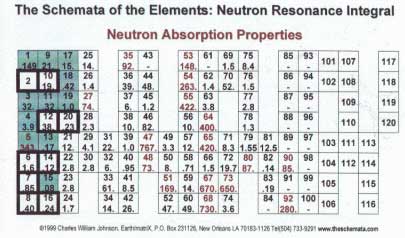
-
by Charles William Johnson
![]()

The Neutronic Schemata of the Elements, presents a neutronic periodic table of the elements, which offers an original format that reveals new patterns of symmetry among the elements and their atoms. Neutronic periodicity serves as the basis for the neutronic schemata. Some of the elements within the first twenty elements of the periodic table have respectively an equal number of protons, electrons and neutrons. The equality determine some of the characteristics and properties of the elements and their atoms, much in the same manner as electronic periodicity on the conventional periodic table.

The conventional periodic table of the elements is based upon the electronic configuration of the atoms. Traditionally, no apparent attempt has been made to visualize a pattern of periodicity within the neutronic count of the elements. The neutronic schemata of the elements, however, overcome the dismembered format of the traditional periodic table. Data and color-coded patterns are rendered onto the neutronic schemata, revealing original patterns of symmetry among the elements.
Neutronic periodicity is a new concept as employed in the schemata, and gives rise to visualizing twenty distinct groups of elements, different from the families and groups visualized on the conventional, electronic configuration table. Data and values that appear to be random or disorganized on the traditional table, once transferred onto the schema's format, reveal symmetries that have gone untreated to date in the literature in chemistry and physics.
The Neutronic Schemata of the Elements shall be presented by Charles William Johnson at Pittcon 2002, at 4:45PM on March 19, 2002 in the session, "Teaching: Innovative Approaches in Science" Education, to be held in Room 235 of the Morial Convention Center in New Orleans.
Contact Information: Charles William Johnson.
Earth/matriX: Science Today,
johnson@earthmatrix.com
| HOME |